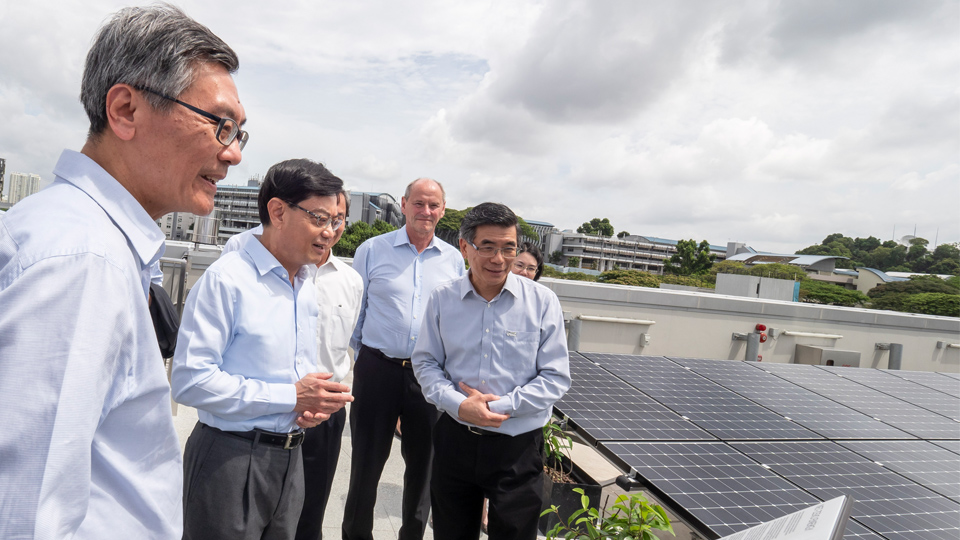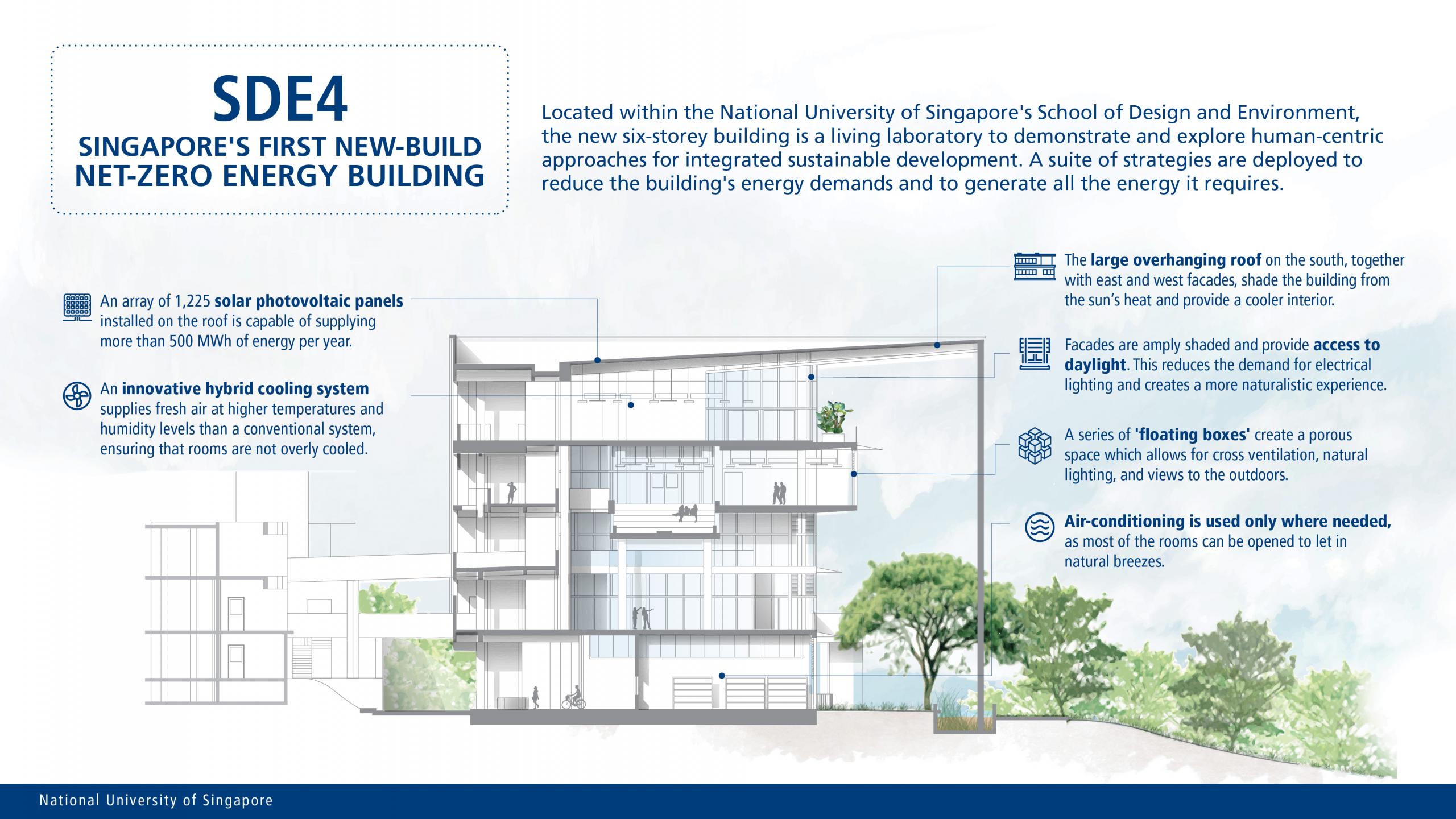New building is also the first component of a 'well and green' precinct that integrates human-centric designs within a sustainable environment
The National University of Singapore (NUS) today unveiled the first new-build net-zero energy building in Singapore. Located within its School of Design and Environment (SDE), the new SDE4 building is energy efficient and environmentally friendly, with a suite of innovative building strategies to improve the comfort and well-being of building users.

Mr Heng Swee Keat, Minister for Finance and Chairman of the National Research Foundation, officiated the launch of SDE4, and visited the building's new facilities.
SDE4 is a new addition to the existing constellation of three buildings serving students and staff of the School. Designed to be climate responsive with net-zero energy consumption, the building features a range of sustainable building designs, such as solar roof installations, a hybrid cooling system, as well as approaches to optimise natural ventilation and lighting. The building has been awarded a Green Mark Platinum certification, and the School is applying for certification by the International WELL Building Institute, which recognises best practices in design and construction with evidence-based health and wellness interventions.
Professor Tan Eng Chye, NUS President, said, "NUS is proud to be home to the first new-build net-zero energy building in Singapore. This is testament to our continuous efforts in incorporating sustainability in various aspects of our campus life - from operations, planning, construction, research and education. The conceptualisation and construction of SDE4, which is also our very first net-zero energy building on campus, involved a collaborative partnership between our resident experts at the NUS School of Design and Environment as well as external consultants, builders and developers. The result is a dynamic living laboratory, showcasing the latest ideas and solutions in sustainable development."
"The School will continue to push the boundaries of innovative design as it embarks on the next phase of transforming three other buildings in the precinct to embrace a 'well and green' philosophy. We hope that this novel concept will inspire future high-performance buildings and sustainable development designs in Singapore and beyond," Prof Tan added.
Pioneering a 'well and green' precinct on campus
As part of its continual efforts to explore new frontiers of sustainable development, the School has incorporated a 'well and green' approach in its teaching and design approaches, with an emphasis on the integration of human-centric design within a sustainable natural and built environment. The completion of SDE4 marks the first milestone in realising the School's vision of creating a 'well and green' zone, called the Engineering and Design & Environment precinct, that will be a prototype of human-centric approaches to future sustainable development in NUS.
Two existing buildings are currently being renovated. One more building will be redeveloped, and this new building will demonstrate the ambitious goal of being net-positive energy, net-zero water, wellness certified and low carbon construction.
Professor Lam Khee Poh, Dean of the NUS School of Design and Environment, said, "The successful completion of SDE4 demonstrates that stringent energy targets for buildings in the tropics are achievable. Through a well-executed integrated design process, the building will also provide a comfortable and biophilic experience coupled with a low carbon footprint. This principle of fusing beauty, comfort, wellness and sustainability will be applied to the other three buildings in the precinct."
SDE4: Energy-efficient spaces that promote well-being
The SDE4 building houses a mix of research laboratories, design studios, as well as teaching and common learning spaces over six floors, covering a gross floor area of 8,588 square metres.
A key aspect of the building is its contemporary architecture design which demonstrates a deep understanding of the tropical climate of Singapore. The concept incorporates a large overhanging roof, together with the double facades on the east and west sides of the building, to shade it from the sun's heat and provide a cooler interior.
Designed to consume only as much energy as it produces, SDE4 is equipped with a solar 'farm' on the roof top comprising more than 1,200 solar photovoltaic panels to harvest solar energy. On days when there is insufficient sunlight, the building will draw energy from the University's power grid.
To effectively manage the building's energy consumption, SDE4 adopts an innovative hybrid cooling system which ensures that rooms would not be overly-cooled. Rooms within the building are supplied with cool air at higher temperatures and humidity levels than a conventional air-conditioning system. Ceiling fans circulate the cool air to generate a comfort condition that is significantly better than overcooled spaces.
The building also makes use of the architectural concept of 'floating boxes', where its shallow plan depth and porous layout allows for cross-ventilation, natural lighting and views to the outdoors. Rooms can also be opened to let in natural breezes. Air-conditioning can be used only where it is needed, reducing the overall electricity usage.
Premised on the idea that a connection with natural systems can enhance human comfort and well-being, SDE4 integrates natural elements and nature-like qualities into its environment, with features that offer uninterrupted views to greenery, visibility of water systems, and access to daylight.
These features make up an architecture that functions as a living laboratory, facilitating the test-bedding and developing of green building technologies, and promoting research collaboration with public agencies and industry partners.
Please refer to the Annex for details on SDE4.
Celebrating 50 years of achievements
The opening of the new SDE4 building also kicked off the year-long celebration of the School's 50th anniversary. In the coming months, the School will hold a bowling tournament to promote interaction and cohesion among students, staff and alumni. The SDE50 Gala Dinner will also be held in October to raise funds for the SDE Development Fund.






